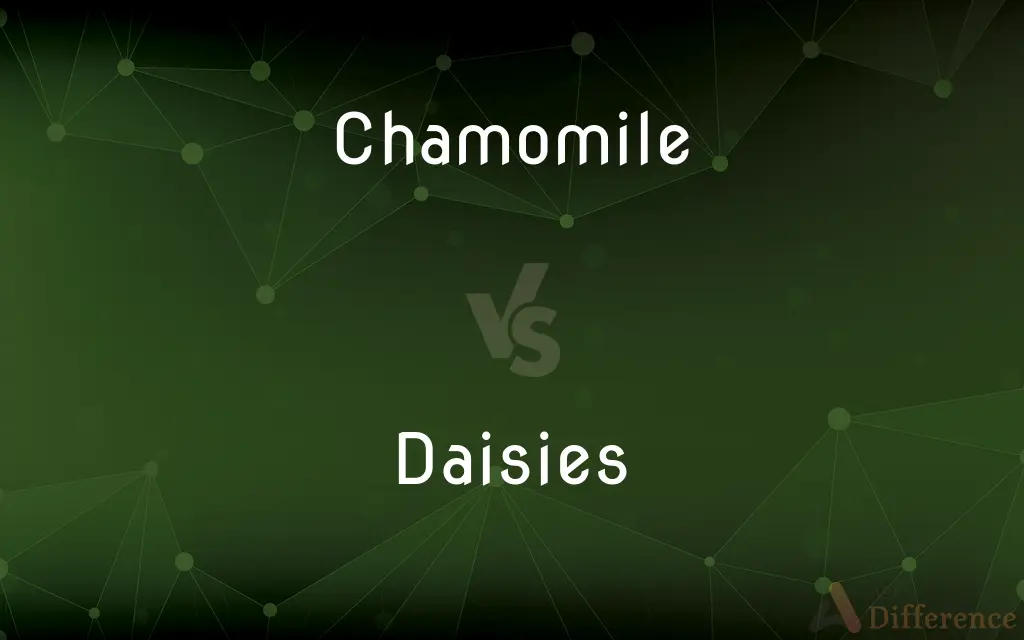Chamomile vs. Daisies — What's the Difference?
By Urooj Arif & Fiza Rafique — Updated on March 31, 2024
Chamomile flowers are renowned for their medicinal properties, particularly in teas, while daisies are appreciated for their aesthetic value and symbolism in gardens.

Difference Between Chamomile and Daisies
Table of Contents
ADVERTISEMENT
Key Differences
Chamomile is a term commonly referring to several daisy-like plants belonging to the Asteraceae family, which are used for their calming, medicinal properties, especially in herbal teas. Whereas daisies, also a part of the Asteraceae family, are known for their simple beauty and wide variety of species, including the classic white and yellow Bellis perennis.
While both chamomile and daisies share a family and possess a similar appearance with their petal arrangement and central disc, chamomile is distinguished by its specific use in herbal remedies and teas. On the other hand, daisies are primarily decorative, celebrated in gardens and floral arrangements for their diverse colors and forms.
Chamomile plants, specifically German chamomile (Matricaria chamomilla) and Roman chamomile (Chamaemelum nobile), are highly sought after for their therapeutic qualities, such as aiding in sleep and digestion. Daisies, in contrast, are often associated with innocence, purity, and new beginnings, making them a popular choice in bouquets and as symbols in literature and art.
The cultivation of chamomile is usually for the purpose of harvesting its flowers, which are dried and used in tea blends, cosmetics, and medicinal products. Daisies, however, are cultivated for their aesthetic appeal and ability to attract pollinators, enhancing the biodiversity of garden environments.
Despite their common characteristics and family ties, chamomile's reputation is primarily as a healing, soothing herb with a mild, apple-like flavor and fragrance. Daisies, while they may not boast the same medicinal properties, hold a cherished place in cultural traditions and are admired for their cheerful appearance and symbolic meanings.
ADVERTISEMENT
Comparison Chart
Family
Asteraceae
Asteraceae
Primary Use
Medicinal (teas, remedies)
Aesthetic (gardens, bouquets)
Key Species
German chamomile (Matricaria chamomilla), Roman chamomile (Chamaemelum nobile)
Bellis perennis, various others
Symbolism
Healing, calm
Innocence, purity, new beginnings
Cultivation Aim
Harvesting flowers for therapeutic use
Decorative appearance, attracting pollinators
Compare with Definitions
Chamomile
Plant of the Asteraceae family, used medicinally.
Chamomile has been used for centuries in herbal medicine.
Daisies
Belongs to the Asteraceae family, known for its simple beauty.
Daisies can brighten any garden with their cheerful colors.
Chamomile
Grown for its flowers, valued in natural remedies.
The chamomile in her garden was ready to be harvested for tea.
Daisies
Features a classic white petal and yellow center appearance.
The field was dotted with the white and yellow of daisies.
Chamomile
A herb known for its calming effects and used in tea.
She drank chamomile tea before bed to help her sleep.
Daisies
Represents purity and new beginnings in symbolism.
Daisies are often given to celebrate new beginnings.
Chamomile
Characterized by daisy-like white petals and yellow disc center.
Chamomile flowers resemble daisies but are smaller.
Daisies
A common garden flower, symbolic of innocence.
He picked a bouquet of daisies for his daughter.
Chamomile
Known for its apple-like fragrance.
The room was filled with the sweet, apple-like scent of chamomile.
Daisies
Cultivated for aesthetic appeal and biodiversity.
Planting daisies helps attract bees and butterflies to the garden.
Chamomile
Chamomile (American English) or camomile (British English; see spelling differences) ( KAM-ə-myl or KAM-ə-meel), is the common name for several daisy-like plants of the family Asteraceae. Two of the species, Matricaria recutita and Anthemis nobilis, are commonly used to make herbal infusions for traditional medicine.
Daisies
A widely naturalized Eurasian plant (Leucanthemum vulgare syn. Chrysanthemum leucanthemum) having flower heads with a yellow center and white rays. Also called oxeye daisy, white daisy.
Chamomile
An aromatic perennial herb (Chamaemelum nobile) in the composite family, native to Europe and the Mediterranean region, having feathery foliage and flower heads with white rays and yellow centers.
Daisies
A low-growing plant (Bellis perennis) native to Europe and widely naturalized, having flower heads with white or pinkish rays. Also called English daisy.
Chamomile
A similar, related Eurasian annual plant (Matricaria recutita).
Daisies
The flower head of any of these plants.
Chamomile
The dried flower heads of either one of these plants, used to make an herbal tea and yielding an oil used in commercial flavorings and perfumery.
Daisies
(Slang) One that is deemed excellent or notable.
Chamomile
Alternative spelling of camomile
Daisies
Plural of daisy
Chamomile
See Camomile.
Chamomile
Eurasian plant apple-scented foliage and white-rayed flowers and feathery leaves used medicinally; in some classification systems placed in genus Anthemis
Common Curiosities
What makes chamomile different from daisies?
Chamomile is primarily used for its medicinal properties in teas, whereas daisies are appreciated for their aesthetic value and symbolism.
How can you tell chamomile and daisies apart?
By their specific uses and the detailed aspects of their flowers; chamomile flowers are smaller with a more pronounced, apple-like scent.
Is chamomile safe for everyone?
Chamomile is generally safe, but people with allergies to plants in the Asteraceae family should avoid it.
Can chamomile and daisies grow together in a garden?
Yes, they can coexist beautifully in a garden, contributing to biodiversity and aesthetic variety.
Can daisies be used in any medicinal or therapeutic ways like chamomile?
Some daisy species have medicinal uses, but they are not as widely recognized or used as chamomile.
Can you drink daisy tea like chamomile tea?
While some daisy species may be edible or have herbal uses, chamomile is specifically sought after for its calming, medicinal benefits.
Are chamomile and daisies related?
Yes, both belong to the Asteraceae family, sharing similar flower structures but differing in uses and symbolism.
What do daisies symbolize?
Daisies symbolize innocence, purity, and new beginnings.
Why is chamomile so popular in herbal remedies?
Chamomile contains compounds that can help soothe the digestive system, reduce anxiety, and promote sleep.
Where do chamomile and daisies grow best?
Both can thrive in temperate climates, but their specific growing conditions can vary depending on the species.
What part of the chamomile plant is used for tea?
The flowers of the chamomile plant are used to make tea.
What is the cultural significance of daisies?
Daisies have been associated with innocence and purity for centuries, often used in art, literature, and folklore.
How do chamomile's medicinal properties affect the body?
Chamomile has anti-inflammatory, antispasmodic, and relaxant properties that can benefit the body in various ways.
Do chamomile and daisies have the same flowering season?
Their flowering seasons can overlap, but it depends on the specific species and growing conditions.
Are there different varieties of chamomile?
Yes, the most well-known are German chamomile (Matricaria chamomilla) and Roman chamomile (Chamaemelum nobile), each with its own characteristics and uses.
Share Your Discovery

Previous Comparison
Chaos vs. Disorder
Next Comparison
Concrete vs. TangibleAuthor Spotlight
Written by
Urooj ArifUrooj is a skilled content writer at Ask Difference, known for her exceptional ability to simplify complex topics into engaging and informative content. With a passion for research and a flair for clear, concise writing, she consistently delivers articles that resonate with our diverse audience.
Co-written by
Fiza RafiqueFiza Rafique is a skilled content writer at AskDifference.com, where she meticulously refines and enhances written pieces. Drawing from her vast editorial expertise, Fiza ensures clarity, accuracy, and precision in every article. Passionate about language, she continually seeks to elevate the quality of content for readers worldwide.
















































